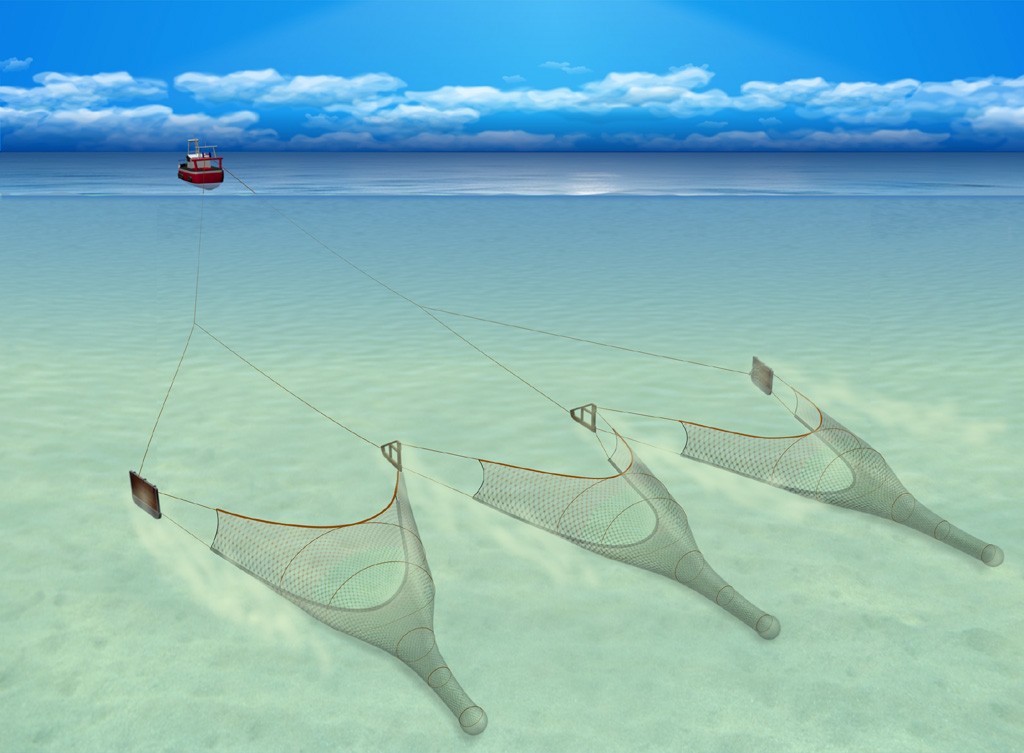Multi Rig Trawl - Sole triple rig
Summary
This is a fishing method used by smaller vessels to target Dover sole. It involves towing three small trawl side by side. The rig is spread using a set of trawl doors on the outside wings and a pair of steel frames in the inside wings. The trawls are very close behind the trawl doors as it is known that sweeps and bridles have very little effect on herding Dover sole.

Environmental impact
Sole nets have a very low headline height, usually less than 750mm thereby minimising the chance of round fish bycatch. They also have a relatively narrow swept area as this gear is operated with no sweeps and brides, reducing herding of unwanted roundfish. They help to make this rig good for species selectivity only really targeting the non herding demersal species that live very close to the seabed such as Dover sole.
The Multi Rig Trawl - Sole triple rig has relatively little seabed impact as it does not cover a wide area of seabed (no sweeps or bridles), the trawl doors and centre skids used are small and lightweight resulting in minimal seabed penetration and abrasion. The gear is generally used in shallow water with muddy substrates where there is frequent natural disturbance of the seabed from wave and current interaction.
Other information
In this version of multi rig trawling, three standard sole nets were rigged to be towed side by side. The two trawl doors are fitted very close to the outer wings of the outside two trawls, with the inner wings and the centre net being supported by a triangular frames, or skids, that is a similar height to the trawl doors. The headlines of the trawls are attached to the top of the trawl door, or skid, and the footrope attached to the bottom of the trawl door, or skid.
Unlike most other trawls, floats are not required on the headlines of these trawls; the height of the trawl is set by the height of the trawl doors and skids where the headline and footrope are attached. Only very short bridles are used between the nets and trawl doors and skids, as the main target species, Dover sole, does not react to the herding effect of sweeps and bridles. This rig is towed using a standard two barrelled trawl winch with two warps that split into four split warps approximately 20 - 25 metres ahead of the trawl doors.
The vessels using this type of rig in the UK are usually less than 14 metres in length, using two or three trawls, each one being between 12 and 20 metres in length, with a height of less than 0.8 metres. Many fishermen still prefer to use the older style of flat wooden trawl doors with this rig, as they work well in shallow water, but some are using the more modern foil style of trawl doors. Despite the gear set up appearing to be complicated many of the vessels are operated single handed, or with only a skipper and crewman on board. Although the main areas of activity for both twin and triple sole rig are the ports in South East England and the Thames estuary, both methods are used by one or two vessels in various other ports around the English coastline.
The main target species is Dover sole, with a few skate and rays on the inshore muddy grounds. There will be a limited by-catch of other species of flats, and a few of the bottom-dwelling demersal fish. Much of the catch from the fishery in South West England is transported directly to the fish auction in Urk, in Holland, for sale. The basic design of this gear, with no sweeps or bridles and the reduced headline height, ensures that it already rates highly in species selectivity. Most of the size selection is done by legislation covering minimum cod-end mesh sizes. However, some fishermen are experimenting with other selectivity and discard reduction devices to further improve the species selectivity and minimise capture of small fish.
Gear classification
Main target species (UK)
-
- Dover Sole
- Rays
- Skates
Possible bycatch
-
- Immature round fish
- Juveniles of the target species